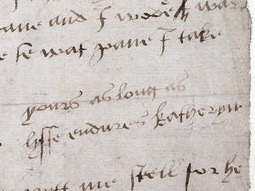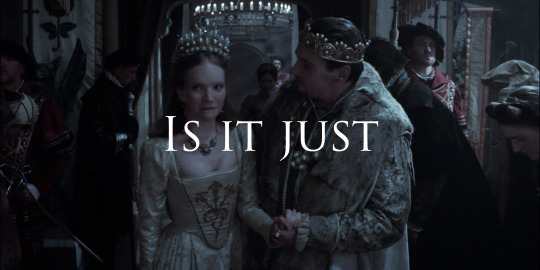#thomas culpeper
Photo








Torrance Coombs as Thomas Culpeper in The Tudors (2007-2010)
#i can't help but call him bash i fear#i need him so bad#torrance coombs#thomas culpeper#the tudors#thetudorsedit#tudorsedit#thetudorsgifs#dailytudors#perioddramaedit#perioddramasource#perioddramacentral#onlyperioddramas#dailytvfilmgifs#tvcentric#misc#by jen
107 notes
·
View notes
Text
#Henry VIII#thomas wolsey#thomas cromwell#Thomas More#Thomas Howard#Thomas Boleyn#Thomas Wyatt#thomas cranmer#Thomas risley#Thomas Seymour#thomas culpeper#polls
105 notes
·
View notes
Text








Tudor Week 2022 day 4/7: Favorite Tudor related relic
Katherine Howard’s letter to Thomas Culpeper, c.1541
“Master Culpeper,
I heartily recommend me unto you, praying you to send me word how that you do. It was showed me that you was sick, the which thing troubled me very much till such time that I hear from you praying you to send me word how that you do, for I never longed so much for a thing as I do to see you and to speak with you, the which I trust shall be shortly now. That which doth comfortly me very much when I think of it, and when I think again that you shall depart from me again it makes my heart die to think what fortune I have that I cannot be always in your company. It my trust is always in you that you will be as you have promised me, and in that hope I trust upon still, praying you that you will come when my Lady Rochford is here for then I shall be best at leisure to be at your commandment, thanking you for that you have promised me to be so good unto that poor fellow my man which is one of the griefs that I do feel to depart from him for then I do know no one that I dare trust to send to you, and therefore I pray you take him to be with you that I may sometime hear from you one thing. I pray you to give me a horse for my man for I had much ado to get one and therefore I pray send me one by him and in so doing I am as I said afor, and thus I take my leave of you, trusting to see you shortly again and I would you was with me now that you might see what pain I take in writing to you.
Yours as long as life endures,
Katheryn.
One thing I had forgotten and that is to instruct my man to tarry here with me still for he says whatsomever you bid him he will do it.”
148 notes
·
View notes
Text





requested by anonymous
#the tudors#katheryn howard#katherine howard#catherine howard#thetudorsedit#katherinehowardedit#my edit#edit#henry viii#thomas culpeper#francis dereham#request
48 notes
·
View notes
Note
Sorry for a bothersome question but I remember you saying that Katherine Howard wasn't technically charged with adultery or executed for adultery (I don't remember which)? And I'm just looking for a little more info since I'm trying to argue this point with some loser on Reddit
no bother at all! she was charged with intent, which legally counted as guilt according to the laws of her time — thomas culpeper confessed that they intended to commit adultery. no evidence of them ever physically committing adultery was found or submitted at trial.
more tangibly, a bill of attainder saw her incited for having a sexual history, and not disclosing that sexual history, prior to marriage. she was guilty of having “led an abominable, base, carnal, voluptuous, and vicious life, like a common harlot, with divers persons [...] maintaining however the outward appearance of chastity and honesty. that she led the king by word and gesture to love her and (he believing her to be pure and chaste and free from other matrimonial yoke) arrogantly coupled herself with him in marriage”. so the case was made that she intended to carry on in this vein and thus, a case was presented for treasonous intent.
in the most simple terms: she was executed for not being a virgin at marriage, which was inferred to mean she was promiscuous by nature, and that assumption facilitated the justification of execution by intent. it’s one of the most depressing, misogynistic and cynical forms of contrived legalism.
if one considers her testimonies during the investigation, she resolutely denied adultery. during her final confession, given at the tower of london, she professed her innocence: she “took god and his angels to be her witnesses, upon salvation of her soul, that she was guiltless of that act of defiling her sovereign’s bed, for which she was condemned”.
“it was immaterial whether or not catherine and culpeper had actually had sex because malicious intent was enough […] though she was innocent of any actual crime, the terms of the 1534 treasons act allowed henry to condemn her for presumptive treason.”
i compiled other quotes in this post!
#kick that losers ass <3#katherine howard#thomas culpeper#really i should make a masterpost at some point
2 notes
·
View notes
Text
I enjoy the music from Six: The Musical, but I truly hope that people aren’t getting their history lessons about these people from it. 👀
#I even kind of got the idea for my URL from 'Six' (''K. Howard'') but... Yeah. 😐 Take it all with a grain of salt. 😬#While I love ''Don't Lose Ur Head''... it borderline vilifies Anne. 😒#The most common belief is that Katheryn's last words were that she wanted to die as Thomas Culpeper's wife so...#It's likely that she had romantic feelings for him. In ''All You Wanna Do'' she just wanted to be besties? 🤨#(Of course there is no confirmation of her having said that.)#six wives of henry viii#six the musical#anne boleyn#katheryn howard#tudor history#commentary#txt
7 notes
·
View notes
Text
My Grimoire Research Library
this is a list of my major resource I've referenced/am currently referencing in my big grimoire project. For books I'll be linking the Goodreads page, for pdfs, websites and videos i'll link them directly.
There are plenty of generalised practitioner resources that can work for everyone but as I have Irish ancestry and worship Hellenic deities quite a few of my resources are centred around Celtic Ireland, ancient Greece and the Olympic mythos. If you follow other sects of paganism you are more than welcome to reblog with your own list of resources.
Parts of my grimoire discuss topics of new age spiritualism, dangerous conspiracy theories, and bigotry in witchcraft so some resources in this list focus on that.
Books
Apollodorus - The Library of Greek Mythology
Astrea Taylor - Intuitive Witchcraft
Dee Dee Chainey & Willow Winsham - Treasury of Folklore: Woodlands and Forests
John Ferguson - Among The Gods: An Archaeological Exploration of Ancient Greek Religion
Katharine Briggs - The Fairies in Tradition and Literature
Kevin Danaher - The Year in Ireland: Irish Calendar Customs
Laura O'Brien - Fairy Faith in Ireland
Lindsey C. Watson - Magic in Ancient Greece and Rome
Nicholas Culpeper - Culpeper's Complete Herbal
Plutarch - The Rise and Fall of Athens: Nine Greek Lives
R.B. Parkinson - A Little Gay History: Desire and Diversity Around the World
Rachel Patterson - Seventy Eight Degrees of Wisdom: A Tarot Journey to Self-Awareness
Raleigh Briggs - Make Your Place: Affordable & Sustainable Nesting Skills
Robin Wall Kimmerer - Braiding Sweetgrass
Ronald Hutton - The Witch: A History of Fear in Ancient Times
Rosemary Ellen Guiley - The Encyclopaedia of Witches and Witchcraft
Thomas N. Mitchell - Athens: A History of the World's First Democracy
Walter Stephens - Demon Lovers: Witchcraft S3x and the Crisis of Belief
Yvonne P. Chireau - Black Magic: Religion and The African American Conjuring Tradition
PDFs
Anti Defamation League - Hate on Display: Hate Symbols Database
Brandy Williams - White Light, Black Magic: Racism in Esoteric Thought
Cambridge SU Women’s Campaign - How to Spot TERF Ideology 2.0.
Blogs and Websites
Anti Defamation League
B. Ricardo Brown - Until Darwin: Science and the Origins of Race
Dr. S. Deacon Ritterbush - Dr Beachcomb
Folklore Thursday
Freedom of Mind Resource Centre - Steven Hassan’s BITE Model of Authoritarian Control
Institute for Strategic Dialogue
Royal Horticultural Society
The Duchas Project -National Folklore Collection
Vivienne Mackie - Vivscelticconnections
YouTube Videos
ContraPoints - Gender Critical
Emma Thorne Videos - Christian Fundie Says Halloween is SATANIC!
Owen Morgan (Telltale) - The Source Of All Conspiracies: A 1902 Document Called "The Protocols"
The Belief it or Not Podcast - Ep. 40 Satanic Panic, Ep 92. Wicca
Wendigoon - The Conspiracy Theory Iceberg
Other videos I haven't referenced but you may still want to check out
Atun-Shei Films - Ancient Aryans: The History of Crackpot N@zi Archaeology
Belief It Or Not - Ep. 90 - Logical Fallacies
Dragon Talisman - Tarot Documentary (A re-upload of the 1997 documentary Strictly Supernatural: Tarot and Astrology)
Lindsay Ellis - Tracing the Roots of Pop Culture Transphobia
Overly Sarcastic Productions - Miscellaneous Myths Playlist
Owen Morgan (Telltale) - SATANIC PANIC! 90s Video Slanders Satanists | Pagan Invasion Saga | Part 1
ReignBot - How Ouija Boards Became "Evil" | Obscura Archive Ep. 2
Ryan Beard - Demi Lovato Promoted a R4cist Lizard Cult
Super Eyepatch Wolf - The Bizarre World of Fake Psychics, Faith Healers and Mediums
Weird Reads with Emily Louise -The Infamous Hoaxes Iceberg Playlist
Wendigoon - The True Stories of the Warren Hauntings: The Conjuring, Annabelle, Amityville, and Other Encounters
#I'm writing this while watching the new SovietWomble video#good way to spend 3 hours#witchblr#witch#witchcraft#pagan#pagan witch#kitchen witch#paganism#hellenic pagan#hellenic witch#grimoire#digital grimoire#book of magic#grimoire resources#witchcraft resources#resource list#witch masterpost#eclectic pagan#witchy#grimoire tips#grimoire inspo#grimoire inspiration
290 notes
·
View notes
Text
“As was usual, the queen’s women frequently encountered the gentlemen of the king’s privy chamber in the course of their duties. Equally naturally, flirtations sprang up, ran their short course and died as regularly as the waxing and waning of the moon. Among the king’s gentlemen in the winter of 1539 was Thomas Culpeper, much in favour with the king. Culpeper was the kind of man who enjoyed useful connections and pretty women, and among the queen’s maids of honour he had both. Katherine and Culpeper had got along well. But Katherine was not a stranger to flirtation, and apparently held firm against him: there would be nothing else unless he promised her something more concrete. This was not part of Culpeper’s plan, and he turned instead to other women. Katherine, unused to rejection, was shocked, sad and no doubt had to watch these other relationships blossom in front of her. ‘Her grief was such’, she later told him, ‘that she could not but weep in the presence of her fellows’, the other girls. But soon the king himself made his interest clear and it was not long before she was elevated above her wildest dreams, and far above Thomas Culpeper.
Queen Katherine chose to make him smart for his earlier rejection. One of his new conquests was Bess Harvey. Bess had previously served Queen Anne Boleyn, and had been among the group of women who had been to view the king’s ships at Portsmouth in August 1539. At some stage in the spring or summer of 1541, Queen Katherine gave Bess a gown of damask and sent Jane, Viscountess Rochford to Culpeper with a pointed message: ‘he did ill to suffer his tenement’ – Bess – ‘to be so ill-repaired’ and so Katherine ‘for to save his honesty’ had covered the cost on it. It was a bold and relatable, if petty, triumph and says much about Queen Katherine’s personality. We don’t know precisely when Katherine played this card, but at some stage after she became queen Katherine and Culpeper reconnected. Of itself this wasn’t necessarily a problem. Queens naturally encountered men who were not the king. They had to work with them: the queen’s council, over half of her household and the entirety of the king’s were men. To interact with men for the sake of politics, patronage and even friendship was normal, but Queen Anne Boleyn’s execution five years previously had shown that such relationships might be all too easily, even wilfully, misinterpreted.”
— Nicola Clark, The Waiting Game
7 notes
·
View notes
Text
Katheryn Howard
Katheryn Howard, the fifth wife of King Henry VIII, remains one of the most tragic figures in Tudor history. Born around 1523 in Lambeth to Lord Edmund Howard and Joyce Culpeper, Katheryn's early life was marked by the complexities and struggles of her noble but impoverished family. Her father, a son of the 2nd Duke of Norfolk, and her mother, with previous children from a previous marriage, navigated a challenging aristocratic landscape.
Katheryn's early years were tainted by relationships that would later haunt her. Her relationship with the music tutor Henry Manox during her time under the Dowager Duchess's care caused the duchess herself to intervene. Subsequently, she engaged in a consummated affair with Francis Dereham, a member of her uncle's household, before catching the eye of King Henry VIII.
Her marriage to the ageing monarch in 1540, immediately following the annulment of his union with Anne of Cleves, led to Katheryn being in a position of prominence. Described as Henry's "rose without a thorn," she faced hostility from courtiers, given her past indiscretions. The Howard family's rise to power through her union only fueled resentment.
However, Katheryn's most significant misstep came in the form of her relationship with Thomas Culpeper, a favourite of the king. Despite her previous entanglements, Katheryn's connection with Culpeper during her brief marriage to Henry was perceived as treasonous. The Archbishop of Canterbury, Thomas Cranmer, brought her premarital liaisons to light, leading to her confession and subsequent condemnation.
On February 13, 1542, Katheryn Howard faced execution at the Tower of London. Despite her youth—some speculate she was only 18—she approached her fate with dignity. Five centuries later, her innocence is debated and it is often speculated if her tale was of tragedy or temptation.
A letter from Katheryn to Thomas Culpepper https://www.thirteen.org/wnet/sixwives/inherwords/ch_words.html
Catherine, according to French ambassador Charles de Marillac, was "a young lady of extraordinary beauty" and of "superlative grace."
#history#women in history#the tudors#katherine howard#katheryn howard#catherine howard#tudor history#english history#16th century#tudors#tudor era
9 notes
·
View notes
Text
So it's November, which means there's a lot of Katherine Howard downfall anniversaries, so I've been thinking a lot about her.
I think calling her stupid is not only callous, it misses the point.
Part of the problem I think is that when we study history we spend most of our time thinking 'what's logical.'
But human beings aren't machines. We're not programmed for survival and only survival. We do things that look illogical from the outside, from the standpoint of pure survival.
Mostly, historians get this. We understand that rebels and martyrs had a higher goal than simply surviving.
But human beings need to live, not survive. In order to do the former, we'll risk the latter. Like the women in the ghetto who risked everything just to hear the story of Gone with the Wind. Especially in an age when life is so short.
Was it wise to write a letter to Thomas Culpeper? No. But is it wise to read banned books? Also no. Why is the latter more sympathetic than the former? Both decisions come from the same place: the need to live rather than survive.
And if we judge historical figures purely by 'were they good at surviving', we aren't very good historians.
80 notes
·
View notes
Text




“Do I really have to tell you how he brought me back to life?”
#katherine howard#henry viii#thomas culpeper#the tudors#tamzin merchant#jonathan rhys meyers#torrance coombs#taylor swift#midnights#lyrics#gif#gifset#perioddramaedit
72 notes
·
View notes
Note
Are Katherine Howard and Thomas Culpeper related? Cause you know Katherine's mother's maiden name is Culpeper.
I don’t know the exact genealogy, but yes, they were definitely related. (It’s also worth noting that the entirety of English nobility at this time were all related so…there’s that.)
11 notes
·
View notes
Text
“… her fate was sealed when it was discovered that she had written to Culpeper stating that she would marry him, if only she were free of Henry. At a time when it was treason even to mention the death of the king, her punishment was clear. Though Dereham and Culpeper refused, even on the rack, to acknowledge any illicit connection with the queen after her marriage, they were condemned to die.”
there is no extant letter from katherine to culpeper stating intent to marry him. the only letter that exists only details that he promised her something unknown and that she was eager to speak to him regarding it.
neither culpeper nor dereham were racked. there’s minimal substantial evidence for torture being undertaken at the tower of london generally — it was not a common occurrence. the only inferences towards torture are vague and apply only to dereham.
#john matusiak#katherine howard#thomas culpeper#i should be paid for the amount of work i put in holding misogynistic lazy historians to account online.....................
2 notes
·
View notes
Photo

Kitty Howard & Thomas Culpeper’s relationship:
*“It was during the spring of 1541, if not before, that Catherine found herself drawn to a handsome young man in the King’s privy chamber. That March, when Henry visited Dover and left her behind at Greenwich, she sought the company of her distant cousin Thomas Culpeper, reputed to be a very handsome man and still unmarried even though he was probably in his mid-to late twenties. She may initially have solicited his advice about the king, or whiled away the time in conversation and dancing, but the innocent friendship quickly developed into a dangerous romantic attachment. In her loneliness, the queen may have desired the flattering attentions of a male friend; perhaps the pair simply indulged in some harmless flirtation, or maybe she thought she could pursue her own personal pleasure as well as keeping the king satisfied. There is even a chance that Catherine hoped to fall pregnant by the young man, in the light of Henry’s disappointment at her failure to conceive. All these have been suggested as reasons for Catherine embarking on an illicit liaison that would eventually cost her her head. Yet history may have judged the young queen too harshly; no actual evidence survives to prove that she and Culpeper actually committed adultery and treason by sleeping together.”
Thoughts? Conor Byrne in his biography on Katherine Howard also gives a good argument on how she might not have been guilty. In her book "Ladies in Waiting", Victoria Sylvia Evans points out that while she does believe she was guilty, unlike her cousin, she wasn't afforded the benefit of the doubt. Her family's enemies just wanted her out of the way. Period.
Whether or not she was guilty, there is no question that up until the accusations leveled against her, she was doing quite well in her position. She had a few bumps along the road, but she did fulfilled her role to the best of her ability. She pleaded for Margaret Pole, Thomas Wyatt and many others, lives in the same fashion as the first of Henry's queens had done in the aftermath of the Evil May Day riots, and after she reconciled herself with her eldest stepdaughter, the two spend a lot of time together and she did a lot for her other stepchildren as well, mainly her cousin the lady Elizabeth.
*From “The Six Wives and the Many Mistresses of Henry VIII” by Amy Licence.
10 notes
·
View notes
Text
La molher de la nèu
In the 16th century, a Hufflepuff muggle born woman, Adbugissa Camula Tudor, a descendant of royalty changed the Wizarding World.
She was the daughter of King Henry VIII and Queen Catherine Howard, born in the Royal Palace in 28 May 1541, but she was raised by Callum duke of Argyll and his mother Ella Alba Bonnie of Scotland, daughter of Blanche Marie Sforza and Maximilian I, and who married Rory Alistair of Argyll, an illegitimate son of James III and Elantia Navia- a Gaulish woman from Burgundy, who had been Edward IV's mistress before meeting James-.
Adbugissa resembled her maternal grandmother Joyce Culpeper and had her mother's honey brown hair, and her names were Occitan as her mother was avid of the Occitan french culture.
In her youth Adbugissa learned the Occitan language and fell in love with it, however Adbugissa was born blind.
Her being a female and not the spare male heir her father wanted, as well as being born blind and the fact that they could not hide it was a key factor in her parents' marriage drift and her mother's subsequential affair with Thomas Culpepper which resulted in her beheading.
Her father hid every evidence of her birth and sent her to Scotland to be raised by his old friend Ella of Scotland and her son Callum who later in life dedicated to the Protestant cause in Scotland.
From an early age, Adbugissa displayed a powerful force of magic and by the age of 11 she went to Hogwarts where she was sorted in Hufflepuff.
She was the best student in her class and thanks to her Hufflepuff won the House Cup in a row of 7 years and even though she was blind, she was able to outsmart everyone by her resourcefulness, she created the Wizarding version of the Braille and received her classes in that way.
Later in life when Adbugissa was 31 years old, she married Philip William, Prince of Orange in 17 July 1574 in secret.
She used to dye her hair in orange color and gave Philip a necklace with both their initials.
She had built a castle in Orange for the commoners, as well as another castle in which she founded a school.
"La Molher de La Nèu"
She was the headmaster of the school and to keep the secrecy she taught her students Occitan language and all the classes as well as the spells were in Occitan, so that no one could find them nor relate them to wizardry, as many wizards were being killed back then in charges of heresy.
Adbugissa also had the Hufflepuff badge built in front of the school and placed a great number of spells to hide it from muggles and was a great advocate for Muggle Borns rights.
After she died in 24 October 1578 her daughter Zoe Catarina of Orange took the charge as headmaster.
PD: I took the liberty to write about a possible daughter of Henry VIII and Catherine Howard, and depict her story, there are many theories whether they had a child, as you can see in this article.
Credits to "Guest Post: Katherine Howard Pregnant by Henry VIII in 1540? By Sylvia Barbara Soberton- Adventures of a Tudor Nerd
I also made up the fictional characters of history as Blanche Marie and Maximilian never had any children James III never had a(n unknown) mistress.
#hufflecrew#hufflepuff queen#hufflepuff#hufflepride#muggleborn#wizarding society#magical history#the wizarding world of harry potter#wizarding world#magical royalty#wizarding schools#hogwarts houses#hogwarts#harry potter headcanon#harry potter
5 notes
·
View notes
Text
Thomas Howard, 3rd Duke of Norfolk, was a courtier and a Tudor survivor, and I think he worked behind the scenes much more than he gets credit for. For instance, I believe that he used Jane Rochford to facilitate Cat Howard's affair with Thomas Culpeper. It's one of the rare times when I actually partly agree with one of Philippa Gregory's historical opinions, although I think that Jane also wanted to help the sixth queen avoid Anne Boleyn's fate, which Gregory certainly doesn't. I also think it's at least possible that he turned on his niece Anne Boleyn in early April 1536, doing nothing to stop the king from executing her even though he knew that Henry was starting to make that decision.
But the topper to Norfolk's life had to be the way it ended. At the end of January, he languished in the Tower, knowing that he was slated for execution. His son had already gone under the axe, so he knew there would be no mercy. And then, like a miracle, the king breathed his last. Norfolk survived and was released, pardoned, and restored to the dukedom in 1553. He even went back to the Privy Council and his military offices. Unlike so many of his relatives and friends, he died peacefully at home on August 15, 1554, and was succeeded by his grandson.

8 notes
·
View notes